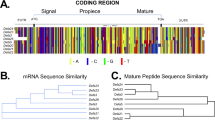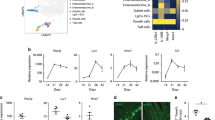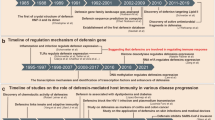Abstract
Paneth cells in mouse small intestinal crypts secrete granules rich in microbicidal peptides when exposed to bacteria or bacterial antigens. The dose-dependent secretion occurs within minutes and α-defensins, or cryptdins, account for 70% of the released bactericidal peptide activity. Gram-negative bacteria, Gram-positive bacteria, lipopolysaccharide, lipoteichoic acid, lipid A and muramyl dipeptide elicit cryptdin secretion. Live fungi and protozoa, however, do not stimulate degranulation. Thus intestinal Paneth cells contribute to innate immunity by sensing bacteria and bacterial antigens, and discharge microbicidal peptides at effective concentrations accordingly.
This is a preview of subscription content, access via your institution
Access options
Subscribe to this journal
Receive 12 print issues and online access
$209.00 per year
only $17.42 per issue
Buy this article
- Purchase on Springer Link
- Instant access to full article PDF
Prices may be subject to local taxes which are calculated during checkout







Similar content being viewed by others
References
Cheng, H. & Leblond, C.P. Origin, differentiation and renewal of the four main epithelial cell types in the mouse small intestine. V. Unitarian Theory of the origin of the four epithelial cell types. Am. J. Anat. 141, 537–561 ( 1974).
Loeffler, M., Stein, R., Wichmann, H.E., Potten, C.S., Kaur, P. & Chwalinski, S. Intestinal cell proliferation. I. A comprehensive model of steady-state proliferation in the crypt. Cell Tiss. Kinet. 19, 627–645 (1986).
Gordon, J.I. Intestinal epithelial differentiation: new insights from chimeric and transgenic mice. J. Cell Biol. 108, 1187– 1194 (1989).
Gordon, J.I., Schmidt, G.H. & Roth, K.A. Studies of intestinal stem cells using normal, chimeric, and transgenic mice. FASEB J. 6, 3039– 3050 (1992).
Boman, H.G. Antibacterial peptides: key components needed in immunity. Cell 65, 205–207 ( 1991).
Boman, H.G. Peptide antibiotics and their role in innate immunity. Annu. Rev. Immunol. 13, 61–92 ( 1995).
Hoffmann, J.A., Kafatos, F.C., Janeway, C.A. & Ezekowitz, R.A. Phylogenetic perspectives in innate immunity. Science 284, 1313–1318 (1999).
Lehrer, R.I., Ganz, T. & Selsted, M.E. Defensins: endogenous antibiotic peptides of animal cells . Cell 64, 229–230 (1991).
Ganz, T. & Lehrer, R.I. Antimicrobial peptides of leukocytes . Curr. Opin. Hematol. 4, 53– 58 (1997).
Ganz, T. et al. Defensins. Natural peptide antibiotics of human neutrophils. J. Clin. Invest. 76, 1427–1435 (1985).
Martin, E., Ganz, T. & Lehrer, R.I. Defensins and other endogenous peptide antibiotics of vertebrates. J. Leukocyt. Biol. 58, 128– 136 (1995).
Selsted, M.E. & Harwig, S.S. Determination of the disulfide array in the human defensin HNP-2. A covalently cyclized peptide. J. Biol. Chem. 264, 4003–4007 (1989).
Hill, C.P., Yee, J., Selsted, M.E. & Eisenberg, D. Crystal structure of defensin HNP-3, an amphiphilic dimer: mechanisms of membrane permeabilization . Science 251, 1481–1485 (1991).
Pardi, A. et al. Solution structures of the rabbit neutrophil defensin NP-5. J. Mol. Biol. 201, 625–636 (1988).
Schonwetter, B.S., Stolzenberg, E.D. & Zasloff, M.A. Epithelial antibiotics induced at sites of inflammation . Science 267, 1645–1648 (1995).
Goldman, MJ et al. Human β-defensin-1 is a salt-sensitive antibiotic in lung that is inactivated in cystic fibrosis. Cell 88 , 553–560 (1997).
Quayle, A.J. et al. Gene expression, immunolocalization, and secretion of human defensin-5 in human female reproductive tract. Am. J. Pathol. 152, 1247–1258 (1998).
Valore, E.V. et al. Human β-defensin-1: an antimicrobial peptide of urogenital tissues. J. Clin. Invest. 101, 1633– 1642 (1998).
Bals, R., Goldman, M.J. & Wilson, J.M. Mouse β-defensin 1 is a salt-sensitive antimicrobial peptide present in epithelia of the lung and urogenital tract. Infect. Immun. 66, 1225–1232 (1998).
Bals, R. et al. Human β-defensin 2 is a salt-sensitive peptide antibiotic expressed in human lung. J. Clin. Invest. 102, 874–880 (1998).
Diamond, G. & Bevins, C.L. β-Defensins: endogenous antibiotics of the innate host defense response. Clin. Immunol. Immunopathol. 88, 221–225 ( 1998).
Ghoos, Y. & Vantrappen, G. The cytochemical localization of lysozyme in Paneth cell granules. Histochem. J. 3, 175–178 (1971).
Harwig, S.S.L. et al. Bactericidal properties of murine intestinal phospholipase A2 . J. Clin. Invest. 95, 603– 610 (1995).
Qu, X-D., Lloyd, K.C., Walsh, J.H. & Lehrer, R.I. Secretion of type II phospholipase A2 and cryptdin by rat small intestinal Paneth cells. Infect. Immun. 64, 5161– 5165 (1996).
Jones, D.E. & Bevins, C.L. Paneth cells of the human small intestine express an antimicrobial peptide gene. J. Biol. Chem. 267, 23216–23225 ( 1992).
Ouellette, A.J. et al. Mouse Paneth cell defensins: primary structures and antibacterial activities of numerous cryptdin isoforms. Infect. Immun. 62, 5040–5047 (1994).
Selsted, M.E., Miller, S.I., Henschen, A.H. & Ouellette, A.J. Enteric defensins: antibiotic peptide components of intestinal host defense . J. Cell Biol. 118, 929– 936 (1992).
Eisenhauer, P.B., Harwig, S.S.L. & Lehrer, R.I. Cryptdins: antimicrobial defensins of the murine small intestine. Infect. Immun. 60, 3556– 3565 (1992).
Porter, E.M., Liu, L., Oren, A., Anton, P.A. & Ganz, T. Localization of human intestinal defensin 5 in Paneth cell granules. Infect. Immun. 65, 2389– 2395 (1997).
Ganz, T. Defensins and host defense. Science 286, 420–421 (1999).
Selsted, M.E., Ouellette, A.J. Defensins in granules of phagocytic and non-phagocytic cells. Trends Cell Biol. 5, 114–119 (1995).
Bevins, C.L., Martin-Porter, E., Ganz, T. Defensins and innate host defence of the gastrointestinal tract. Gut 45, 911–915 (1999).
Wilson, C.L. et al. Regulation of intestinal α-defensin activation by the metalloproteinase matrilysin in innate host defense. Science 286, 113–117 (1999).
Satoh, Y., Ishikawa, K., Ono, K. & Vollrath, L. Quantitative light microscopic observations on Paneth cells of germ-free and ex-germ-free Wistar rats. Digestion 34, 115– 121 (1986).
Satoh, Y. & Vollrath, L. Quantitative electron microscopic observations on Paneth cells of germfree and ex-germfree Wistar rats. Anat. Embryol. 173, 317–322 (1986).
Satoh, Y., Habara, Y., Ono, K. & Kanno, T. Carbamyl choline- and catecholamine-induced intracellular calcium dynamics of epithelial cells in mouse ileal crypts. Gastroenterology 108, 1345–1356 (1995).
Cano-Gauci, D.F. et al. In vitro cDNA amplification from individual intestinal crypts: A novel approach to the study of differential gene expression along the crypt-villus axis. Exp. Cell Res. 208, 344–349 (1993).
Fields, P.I., Groisman, E.A. & Heffron, F. A Salmonella locus that controls resistance to microbicidal proteins from phagocytic cells. Science 243, 1059–1062 (1989).
Miller, S.I., Kukral, A.M. & Mekalanos, J.J. A two-component regulatory system (phoP phoQ) controls Salmonella typhimurium virulence. Proc. Natl Acad. Sci. USA. 86, 5054–5058 (1989).
Garabedian, E.M., Roberts, L.J., McNevin, M.S. & Gordon, J.I. Examining the role of Paneth cells in the small intestine by lineage ablation in transgenic mice. J. Biol. Chem. 272, 23729–23740 (1997).
MacPhee, M. et al. The secretory phospholipase A2 gene is a candidate for the Mom1 locus, a major modifier of ApcMin-induced intestinal neoplasia. Cell 81, 957– 966 (1995).
Bals, R. et al. Mouse β-defensin 3 is an inducible antimicrobial peptide expressed in the epithelia of multiple organs. Infect. Immun. 67, 3542–3547 (1999).
Aley, S.B., Zimmerman, M., Hetsko, M., Selsted, M.E. & Gillin, F.D. Killing of Giardia lamblia by cryptdins and cationic neutrophil peptides. Infect. Immun. 62, 5397–5403 (1994).
Bjerknes, M. & Cheng, H. Methods for the isolation of intact epithelium from the mouse intestine. Anat. Rec. 199 , 565–574 (1981).
Selsted, M.E. Investigational approaches for studying the structures and biological functions of myeloid antimicrobial peptides. Genet. Eng. 15, 131–147 (1993).
Selsted, M.E. & Becker, H.W. Eosin Y: a reversible stain for detecting electrophoretically resolved protein. Anal. Biochem. 155, 270–274 ( 1986).
Wang, M-S.C., Pang, J.S. & Selsted, M.E. Semidry electroblotting of peptides and proteins from acid-urea polyacrylamide gels. Anal. Biochem. 253, 225–230 (1997).
Paulus, U., Loeffler, M., Zeidler, J., Owen, G. & Potten, C.S. The differentiation and lineage development of goblet cells in the murine small intestinal crypt: experimental and modelling studies. J. Cell Sci. 106, 473–483 (1993).
Acknowledgements
We thank S.B. Aley (University of Texas, El Paso) for live G. lamblia trophozoites; J.I. Gordon (Washington University School of Medicine) for CR2-tox176 transgenic mice and P. Tran for technical advice on AU-PAGE western blotting. Supported by NIH Grants DK44632 (A.J.O.), HL29594 (W.C.P.) and AI 22931 (M.E.S.) and also by Large Scale Biology Corp.(M.E.S.).
Author information
Authors and Affiliations
Corresponding author
Rights and permissions
About this article
Cite this article
Ayabe, T., Satchell, D., Wilson, C. et al. Secretion of microbicidal α-defensins by intestinal Paneth cells in response to bacteria. Nat Immunol 1, 113–118 (2000). https://doi.org/10.1038/77783
Received:
Accepted:
Issue Date:
DOI: https://doi.org/10.1038/77783
This article is cited by
-
Loss of Mptx2 alters bacteria composition and intestinal homeostasis potentially by impairing autophagy
Communications Biology (2024)
-
Efficient recombinant production of mouse-derived cryptdin family peptides by a novel facilitation strategy for inclusion body formation
Microbial Cell Factories (2023)
-
Mechanisms and regulation of defensins in host defense
Signal Transduction and Targeted Therapy (2023)
-
Decreased Paneth cell α-defensins promote fibrosis in a choline-deficient L-amino acid-defined high-fat diet-induced mouse model of nonalcoholic steatohepatitis via disrupting intestinal microbiota
Scientific Reports (2023)
-
Lower human defensin 5 in elderly people compared to middle-aged is associated with differences in the intestinal microbiota composition: the DOSANCO Health Study
GeroScience (2022)



